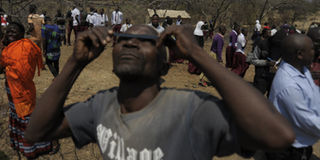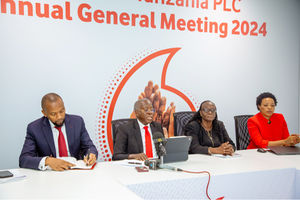TRAVEL : A trip to Mbeya, the land of rice and Irish potatoes

An elderly man uses special glasses to view the annular solar eclipse in Rujewa, Mbeya.PHOTOI FILE.
What you need to know:
- According to my Dar Lux bus ticket, reporting time was at 5:30am, and the 826.7km journey would start at 6:00am. However, we took off half an hour late, at 6:30.
- While those who were in the bus on time were annoyed, the delay was a blessing to the latecomers for they would have missed the bus.
It was early on the morning of 29th August, 2016 when I set off for the Ubungo Bus Terminal ready for the trip to Rujewa. I had been assigned to cover the historical annular solar eclipse in Mbeya Region’s Mbarali district on September 1.
According to my Dar Lux bus ticket, reporting time was at 5:30am, and the 826.7km journey would start at 6:00am. However, we took off half an hour late, at 6:30.
While those who were in the bus on time were annoyed, the delay was a blessing to the latecomers for they would have missed the bus.
The ride to Mbeya was smooth especially given that our driver observed the 50km per hour speed limit. He had to do so because traffic police officers were everywhere and he could not risk overspeeding. The officers would stop the buses to check whether the passengers were wearing their seat belts, check the bus timetables and advise passengers to fasten their seat belts.
As we were about to arrive at the Msamvu Bus Stand in Morogoro, the bus took a right turn and stopped at Tungi Hotel where we were given ten minutes to relieve ourselves and have breakfast.
Not everybody took their breakfast at the hotel given the high cost compared to some eateries in Dar es Salaam. An andazi that costs Sh 200 in Dar es Salaam went for Sh 1,000, which is way too expensive.
We were back in the bus after exactly ten minutes. At Msamvu bus stand where we went to pick Morogoro passengers, fruits and vegetable vendors surrounded the bus as they tried to convince passengers to buy tomatoes, onions and the likes at cheaper prices compared to that of a few months ago when I passed at the area during a previous trip.
A 10-liltre bucket of tomatoes that was sold between Sh10,000 and Sh15,000 that time was sold for only Sh2,000.
At Mzumbe, I asked one of the vendors through the bus window the reason for the slump. The vendor, who identified himself as Muhogo Mchungu told me there has been overproduction of tomatoes this year and that the Dar es Salaam markets are flooded.
Some farmers, according to the flamboyant man, just leave the tomatoes to rot in their farms because they can’t afford the cost of transporting the produce to the markets.
This depicts the life of many Tanzanian farmers, who toil in the farm for their crops to either rot in their gardens or to sell them at a thro-away-price. I just could not stop thinking about the plight of Tanzanian small holder farmers as we cruised to Mbeya, the land of rice and Irish potatoes.
We arrived at Mafinga in Iringa at almost 4:00pm. From Mafinga, the journey was not as smooth as contractors were at work rehabilitating the busy Iringa-Makambako-Mbeya road.
Because of a lot of road diversions, dust became a part and parcel of our journey, hindering us from seeing the thick forests along the road. However, we were lucky because our bus was fully air conditioned.
The problem was that the bus conductor was not doing his job well enough. He did not alert his passengers about the next bus stops and important centres and so I had to notify the conductor that I was getting off at Igawa in advance. Twenty minutes later, to my surpise, the conductor announced that those alighting at Igawa should get prepared as we were approaching the place, meaning I could have gone past Igawa to God knows up to where.
We safely arrived at Igawa in Mbarali district at 6:30pm. “Kaka vitunguu, vitunguu vizuri,” women selling onions welcomed us, convincing us to buy onions. My colleague and I were swarmed up by boda boda riders as we looked for someone to show us the direction to Rujewa, a town closer to the area designated for witnessing the historical solar eclipse event.
A Good Samaritan gave us the directions after which we took a tri-cycle (Bajaj) to Rujewa town, some 10- hours drive. We arrived at the small town at 7pm and managed to find a guest house.
After taking a shower, we went to the restaurant within the compound for dinner.It took nearly 20 minutes to be served with rice and beef, the only dish available. The waitress who took our order had even forgotten the types of drinks we had ordered.
The following day, I visited the area specified for witnessing the annular solar eclipse, and found astronomer, Dr Noorali Jiwaji, busy supervising preparations for welcoming the event.
As the clock ticked towards September 1st, Rujewa town became busy as people from Mbeya city, Morogoro, Arusha, Kilimanjaro, Songwe and neighbouring countries started coming in droves to witness the eclipse.
Boda boda and Bajaj riders cashed in on the occasion as the number of customers soared.
“This event will remain etched in our memories forever. There are lots of customers today. We have never experienced such good business before,” one of the bodaboda riders remarked.
Guest houses were flooded. Many people could not find accommodation and had to spend the night at the area where the event was to be witnessed the following day. It was a celebration there as people drank, ate nyama choma and danced all night long.
Come September first, at 9am the area was flooded by people from all walks of life and places ready to witness the solar eclipse, which happened last in the country in 1977.
People were excited at how the sun changed, subsequently affecting the light. The temperature dropped as well and it kind of got dark though briefly. At this juncture, everyone was busy with their phones, snap chatting and taking selfies. Indeed people were happy.
Regional and district leaders used the opportunity to promote local tourism. Tanzania Tourist Board and Tanzania National Parks Authority officials were also there to do the same.
A similar event, it is said, will happen again in Tanzania in 15 years. Should we wait for such a long time to promote our tourist attractions? No. We need to continuously promote domestic tourism and not wait for natural events like the solar eclipse.




